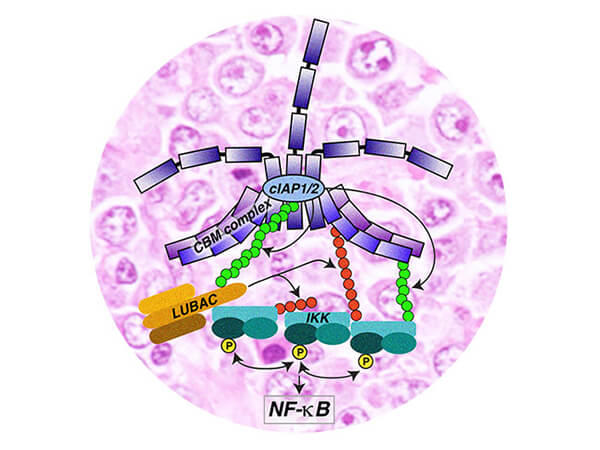New Treatment Target Identified for Diffuse Large B-Cell Lymphoma
, by NCI Staff
NCI researchers have identified new therapeutic targets in a common subtype of diffuse large B-cell lymphoma (DLBCL). Drugs that hit these targets, known as SMAC mimetics, are already under clinical development, and the research team hopes to begin testing them in clinical trials of patients with DLBCL.
In a study published April 11 in Cancer Cell, the NCI researchers showed that the proteins cIAP1 and cIAP2 control the activity of a key signaling pathway in B cells that drives proliferation and survival in the ABC subtype of DLBCL (ABC DLBCL). In cell lines and animal models of the ABC subtype, they found that SMAC mimetics, which inhibit cIAP1 and cIAP2, killed cancer cells and shrank tumors.
The study identifies a new component of the B-cell receptor (BCR) signaling pathway “that was not previously described in the literature,” explained senior author, Louis M. Staudt, M.D., Ph.D., director of NCI’s Center for Cancer Genomics.
And, importantly, Dr. Staudt stressed, “the BCR pathway is already a clinically validated therapeutic target in ABC DLBCL, so we're eager to test SMAC mimetics in clinical trials involving patients with ABC DLBCL.”
Discovering another Treatment Target
DLBCL is the most common form of non-Hodgkin lymphoma, accounting for nearly one-third of NHL diagnoses. Earlier genomic studies conducted by Dr. Staudt’s lab identified two distinct molecular DLBCL subtypes—ABC, which is the least curable with current therapy, and GBC.
A hallmark of the ABC subtype is the continuous activation of the BCR signaling pathway, which promotes cell survival and spurs the growth and spread of the disease. Signaling from the BCR activates a protein complex called NF-κB that promotes cell survival by overriding signals for apoptosis, a form of cell death.
Ibrutinib (Imbruvica®)—which in mid-stage clinical trials has shown promising results in some patients with ABC DLBCL—disrupts NF-κB by blocking the activity of a protein called Bruton’s tyrosine kinase, another component of the BCR signaling pathway.
Additional treatment options are still needed, however, so the NCI research team, led by Yibin Yang, Ph.D., looked for other components of the BCR signaling pathway that might be possible therapeutic targets.
Newly Identified Players in the BCR Pathway
In the study, genomic analyses of ABC subtype tumor samples showed that the tumors often had multiple copies, or amplification, of the genes that code for the cIAP1 and cIAP2 proteins, the research team reported. These genes were rarely amplified, however, in GBC-subtype tumors.
Further studies using cell lines of the ABC subtype suggested that cIAP1 and cIAP2 play key roles in the BCR pathway. For example, treatment with SMAC mimetics proteins or silencing the genes that code for cIAP1 and cIAP2 ramped down NF-κB activity and produced genetic changes that are often seen in B cells when NF-κB activity is disrupted.
Additional experiments showed that cIAP1 and cIAP2 “are intimate and essential members” of another protein complex called CBM, Dr. Staudt said. The CBM complex is “a key intermediate,” he explained, between the B-cell receptor, which sits on the surface of B cells, and other components in the BCR pathway that activate NF-kB.
Several SMAC mimetics, including one that is furthest along in clinical development, called birinapant, reduced cIAP1 and cIAP2 levels in ABC subtype cell lines. Further studies in a variety of DLBCL cell lines showed that birinapant had this effect only in cancer cells that depend on BCR signaling for survival.
And, in two different mouse models of BCR signaling-dependent DLBCL, birinapant substantially shrank tumors while causing no evident toxicity.
The study “makes a strong case for [testing] birinapant in DLBCL,” but only in the ABC subtype, wrote Ueli Nachbur, Ph.D., of the Walter and Eliza Hall Institute of Medical Research, and John Silke, Ph.D., of the University of Melbourne, in an accompanying editorial.
Birinapant and other SMAC mimetics haven’t shown signs of clinical efficacy in early-phase trials of patients with solid tumors or leukemia, Dr. Staudt noted. “But birinapant has been shown to hit its target when delivered in humans, that there is degradation of cIAP1 and cIAP2.”
And, he added, SMAC mimetics appear to be safe.
“So we’re very interested in pursuing clinical trials in patients with ABC DLBCL, because we think that these drugs haven’t had their best shot yet.”
NCI is in early discussions with several companies that have developed SMAC mimetics about pursuing human trials, Dr. Staudt said.
